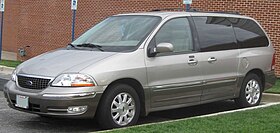This article needs additional citations for verification. (June 2019) |
| Ford Windstar | |
|---|---|
 Ford Windstar Limited, second generation example | |
| Overview | |
| Manufacturer | Ford Motor Company |
| Also called | Mercury Monterey (see below) |
| Model years |
|
| Body and chassis | |
| Class | Minivan |
| Layout | FF layout |
| Chronology | |
| Predecessor |
|
| Successor | Ford Freestar Ford Galaxy (Europe) |
The Ford Windstar (later the Ford Freestar and Mercury Monterey) is a minivan that was produced and sold by Ford. The replacement for the Ford Aerostar, the Windstar adopted the front-wheel drive configuration of the Chrysler minivans. From the 1995 to 2007 model years, three generations of the model line were sold, with the final generation renamed as the Ford Freestar.
Unrelated to the Nissan-developed Mercury Villager, the Windstar was marketed without a Lincoln-Mercury counterpart. As part of the 2004 launch of the Ford Freestar, Mercury introduced its first Ford-produced minivan in a revival of the Mercury Monterey nameplate.
Following a decline in sales across the minivan segment in the mid-2000s, the Freestar and Monterey were discontinued after the 2007 model year with no direct replacement. In North America, the model line was functionally matched by the 7-passenger 2008 Ford Taurus X wagon/CUV; in Mexico, the Freestar was replaced by the Ford Transit/Tourneo. In 2014, Ford reentered the segment as the Ford Transit Connect compact MPV gained 7-passenger seating in North America.
During its production the Ford Windstar/Freestar and the Mercury Monterey were sourced from Oakville Assembly (Oakville, Ontario). In total, 1,984,232 were produced (1,704,786 Windstars, 246,493 Freestars, and 32,953 Montereys).